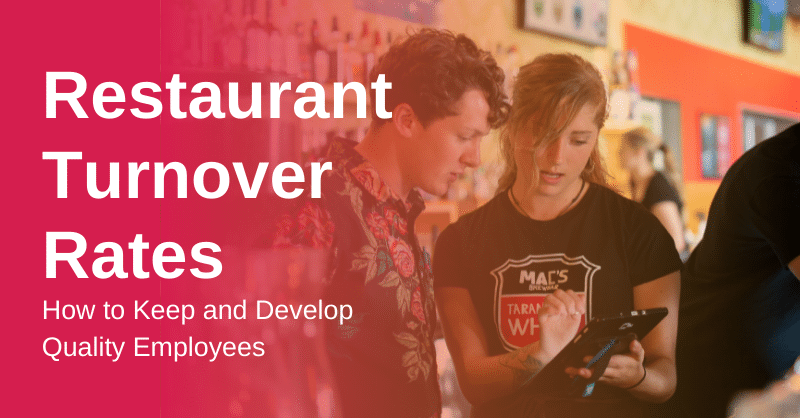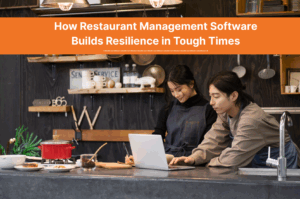Updated on: March 23, 2023
Turnover—the dirty word every employer dreads. If you’re wondering why you can’t seem to hold on to employees, you’re not alone. In fact, 75% of restaurant managers say that hiring and keeping employees is their number one challenge. You may not be surprised to hear that restaurant turnover has been on the rise since 2010 when it was at 57.1%. This was the most recent low-point for the industry.
Since then, turnover rates have only gotten worse across the board. Restaurants, however, are being hit the hardest. Just take Panera, for example. The Department of Labor shared insights on why restaurants have been hit so hard and how some restaurants are handling it.
Best Ways to Improve Your Restaurant Turnover Rate
That average turnover rate is estimated to reach 150%, according to CNBC. That means you could have to replace your entire staff in just one year! The bottom line is, if you want to survive in the restaurant industry for years to come, you must be willing to adapt and reform in creative ways.
So let’s talk about restaurant turnover rates. We’ll specifically cover why they matter, what makes a good restaurant turnover rate, and actionable strategies that will help you lower restaurant turnover most effectively.
Why do restaurant turnover rates matter?
One of the biggest reasons restaurant turnover rates matter is that turnover costs anywhere from $2,000 to $20,000 per employee! That’s a costly expense your restaurant simply can’t afford. Note that this combines both hourly employees (which averaged lower costs) and managers (which averaged much higher). There are also adjustment costs that your team faces each time they have to adjust to one less team member. These are harder to measure but equally important.
That said, if you only focus on the cost of recruitment and retention, you’ll have missed on several key factors that impact restaurant turnover rates. Today we’ll mainly talk about restaurant reputation and culture, which both directly impact customer and employee satisfaction.
Restaurant reputation
In today’s world, anyone can leave a shining or scathing review for all online to see. This means reputation has never been more important. Customers don’t like having to wait long for their orders and will likely tell people about it if they do. Keeping well-staffed is essential to restaurant success.
Customers also don’t like when staff get their orders wrong. They’ve come expecting the best restaurant hospitality, as they should. More employees, especially when they’re seasoned, means a smoother experience. Newer employees often make more mistakes, no matter how well-intending they are. Thus having experienced staff to take over in intense situations is important.
Culture
Thanks to sites like Indeed and Glassdoor, your restaurant’s culture is now visible to prospective employees. Current and former employees can now share key information about your restaurant with prospective hires. Working is stressful enough that culture needs to be a priority for your restaurant. If you can cultivate a positive one, you’re more likely to draw in even your competitors’ quality employees.
Having a good culture in your restaurant brings new challenges, though. You must guard it carefully against gossip and other toxic behaviors, which will drive away quality employees. It takes a lot of work to listen to and implement employee feedback. It requires faith in employee decision-making. This is far from an exhaustive list, but it’s worthwhile to foster a healthy culture in your restaurant.
For one, good culture supports happy and healthy employees. When employees are happy and healthy, they outperform unhappy ones. They need less breaks and time off. They will go to bat for you when a prospective employee asks about the restaurant. These happy, healthy employees are far more likely to stick around, too. This will decrease your turnover rate.
What is a good turnover rate for a restaurant?
Some report that the restaurant turnover rate is around 75%. That said, this metric will honestly depend on how you measure turnover. Do you only measure voluntary separations, or do you include involuntary separations as a way to measure the overall turnover? Do you measure turnovers from the first year of employment alone, or do you measure every year from the hire date?
The hospitality industry as a whole has a higher average turnover than most industries, so you will want to compare your rate to the national average. Also, keep in mind that if lower quality staff members are leaving, a higher rate could be a good thing. “Good” is really subjective.
How do I lower my restaurant employee turnover?
So. We’ve talked about why it’s important to focus on employee turnover. We’ve talked about things to think about when calculating a good turnover rate for your restaurant. Now let’s talk about how to lower that rate. Here are three ways to do just that.
- Focus on the hiring and training processes
- Remember the golden rule
- Exit surveys
Focus on the Hiring Process
Finding the right candidates for your team is key. Interestingly, the restaurant industry has less luxury to sift through candidates. Why? Go too slow and you risk the candidate going to a competitor. Go too fast and you may regret your decision because the candidate wasn’t such a good fit.
But this isn’t the only aspect you should focus on in the hiring process. You must also strategically track results. Where do the best candidates come from? Which candidates did you like most? Who do you contact first? Know the answers to these questions. It can maximize your efforts and bring the best quality talent onto your team.
On the flip side, not knowing can cost you time, money, your reputation, and even your best hires. Technology isn’t a blessing here; it’s a must. Only you can decide what works best for your restaurant.
Remembering the golden rule
Let’s cover just a few points here. Is your restaurant a place you would want to work? And are you seeing people as they really are?
Is it a place you would want to work?
For many, compensation is the most important factor here. In today’s job market, workers want fair compensation. You likely need to employ new tactics to draw them in. Workers are beginning to see that surviving on tips is no longer enough. As prices rise and people see tipping as less of a necessity, it’ll be more true than ever.
Historically, tipping has been culturally accepted in the U.S., but not in most other countries. Some even consider tipping offensive. The U.S. is a melting pot of backgrounds, including a steady inflow of immigrants. It’s not likely we’ll ever see an end to the tipping culture.
Consider the trend-setter move. Push away from that model to a set pay model with no tips. Pay out benefits if you can. Include insurance, retirement accounts, start-on bonuses, and other perks. Phone plan discounts or access to paid ski-resort passes are good examples.
Also consider the environment. Is there user-friendly technology? Is the environment safe or toxic? Are there enough people to cover the day-to-day work? Reducing employee frustrations and stresses can dramatically reduce turnover as well.
In short, if you would like working there, chances are your employees would too.
Understand your people
This point goes along with the section above. People are people, not assets. So never refer to them in that way.
Just like you, your employees want to enjoy their work. They also want to enjoy their lives outside of work. So check in on your employees. See how they’re doing, and ask how their family is. See if they feel equipped to handle their responsibilities. If you can play to their strengths, they’ll feel more fulfilled and satisfied.
Recognize that for most of your workers, this job is a stepping stone in their journey to something else. As such, you can be a great leader and mentor to them if you want to. Celebrate their accomplishments with them. Help them work through their failures and mistakes.
Life is all about learning. The more you can help your employees learn at work, the more they’ll appreciate and remember you.
Exit surveys
Most employees are willing to stay if you give them a reason to. Fostering an environment of openness and willingness to change gives you that reason. It may not benefit the exiting employees, but it’ll certainly benefit those they’re leaving behind.
The outlook on restaurant turnover going forward
Turnover will always be an issue. That’s just the nature of the restaurant industry. The good news is that if you focus on the tips we’ve shared, you can reduce turnover. Even if it’s not possible to completely eliminate turnover, another thing you can do is improve employee experience in order to retain employees. Focus on hiring and training, offer great benefits, and treat people well.
Need tools to help reduce turnover and keep employee morale high? Our HR software could be a good first step. If you’re looking for a demo, don’t hesitate to reach out.






